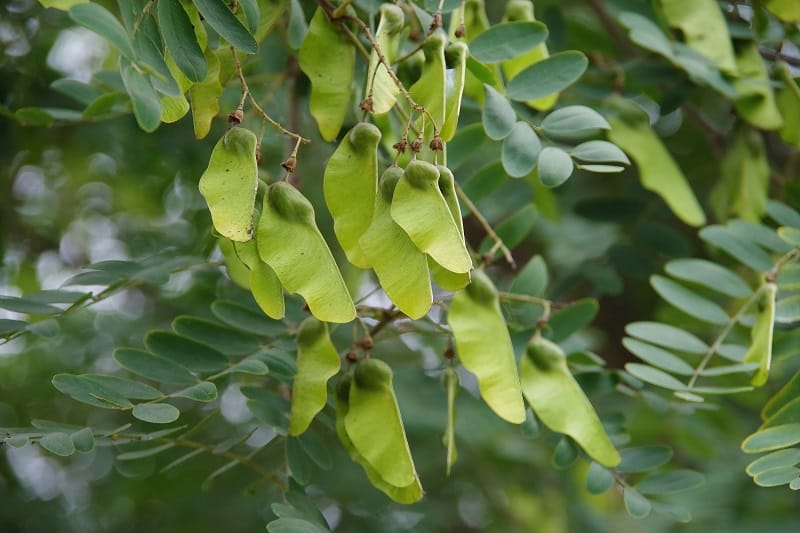
Tipu trees are also called Tipuana tipu, tipa, rosewood, and pride of Bolivia. These South American trees are the only members of the genus Tipuana, and are native to Bolivia. They are medium-sized flowering trees with pea-shaped yellow or apricot flowers, and are usually grown in warmer countries. They can grow as high as 60 feet and the same in width, but are also prone to disorders that cause yellowing leaves.
Tipu Tree Leaves Turning Yellow: What Are The Common Causes?
Pest infestations
The leaves of tipu trees may turn yellow because of the presence of tipu psyllid pests. Both nymphs and adults feed on phloem, the vascular plant tissue that conducts sugars and other metabolic products from the leaves. All life stages of the tipu psyllid, with the exception of the eggs, attack and feed on young leaves and branches. The leaves tend to curl, become yellowish and drop prematurely.
The tipu psyllid nymphs produce a pelletized, wax-like residue, while both adults and nymphs excrete honeydew. This fosters the growth of black sooty mold on the branches and leaves.
Another pest that invades tipu trees is the spittlebug, which is prevalent in Southern California and Arizona. This pest comes from Africa and the larval and nymph stages feed on the sap of tipu leaves. Spittlebugs produce protective nests of foam from the plant’s sap. They excrete this foam in large amounts, causing wet patches on the soil.
Adult spittlebugs are around a quarter-inch long, but are not usually seen. They are green in color but eventually turn brown or grey. Adults are also called froghoppers and have enlarged hind legs for jumping.
Chlorosis
Tipu leaves turning yellow could be a sign of chlorosis. This is the absence of normal green coloration in the leaves, typically caused by iron deficiency due to lime-rich soil, lack of light or disease. The low chlorophyll production results in yellowing leaves.
Chlorosis may also be caused by overwatering, root damage or damage to the trunk. Leaves will first turn yellow-green and eventually become more yellow as the condition progresses. If this is left untreated, leaf edges and veins could turn brown and die; the branches will also die and the tree’s growth will be stunted.
Mineral deficiency
Trees need many elements to function properly, including iron, nitrogen, magnesium, boron and manganese. Without these nutrients and minerals, tipu leaves may become brittle and turn yellow. Nitrogen-deficient leaves may develop a mottled pattern, while those that are magnesium-deficient will manifest yellowing around the base of the leaves. Mineral deficiencies are usually resolved by adding the missing nutrients to the soil via fertilizers.
Tipu Tree Care
Tipu trees are tropical plants and thrive in areas with full or partial sun, with at least six hours of direct sun each day. Be extra selective in finding a good site to plant these trees. Tipu trees have large trunks that buttress at the base, and they are not very particular when it comes to soil type. They can grow in dry or moist soil that can be clay, loam or sandy soil, and are happy in both acidic and slightly alkaline soil. These trees are drought-resistant, but still should be provided with regular irrigation, especially during hot weather.
You should learn more about the tipu tree species if you are planning to grow these trees. They usually thrive in warm climates, such as the US Department of Agriculture hardiness zones nine to 11.
Tipu trees can go weeks without supplemental water, but when they are first planted and young they should be given deep watering. This will help settle the soil around the roots and help you determine if more soil should be leveled around the tree. A drip system is ideal to keep the soil moist but not too wet.
These trees should be pruned during the winter. Prune the lower branches and you will be able to develop the canopy into an umbrella shape. See to it that you have the right tools, especially a pruning saw and pruning lopper as well as a chainsaw. Remove all branches that touch other limbs, and prune branches that don’t produce much foliage.
Conclusion
Tipu trees are renowned landscape trees and are known for their dainty flowers. They are drought-resistant, but are also prone to disorders that can cause yellowing leaves. Some causes of yellowing tipu leaves could be pest infestation, chlorosis or mineral deficiency.
Image: istockphoto.com / Jack N. Mohr